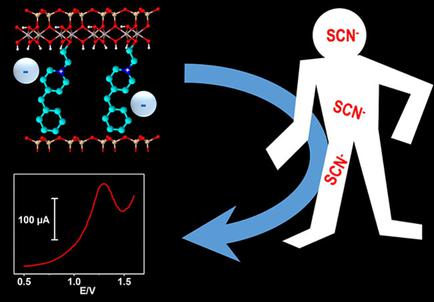当前位置:
X-MOL 学术
›
Electroanalysis
›
论文详情
Our official English website, www.x-mol.net, welcomes your
feedback! (Note: you will need to create a separate account there.)
Sensitive Amperometric Determination of Thiocyanates at Ionic Liquid Nanohybrid Kaolinite Modified Glassy Carbon Electrode
Electroanalysis ( IF 2.7 ) Pub Date : 2018-01-19 , DOI: 10.1002/elan.201700821 Bruno Boniface Nguelo 1 , Gustave Kenne Dedzo 1, 2 , Ignas Kenfack Tonle 1, 3 , Christian Detellier 2 , Emmanuel Ngameni 1
Electroanalysis ( IF 2.7 ) Pub Date : 2018-01-19 , DOI: 10.1002/elan.201700821 Bruno Boniface Nguelo 1 , Gustave Kenne Dedzo 1, 2 , Ignas Kenfack Tonle 1, 3 , Christian Detellier 2 , Emmanuel Ngameni 1
Affiliation

|
Electrochemical sensors have been developed by modifying a glassy carbon electrode with organo‐kaolinite hybrid materials. These materials were obtained by the grafting of four ionic liquids (1‐(2‐hydroxyethyl)‐4‐benzylpyridinium chloride, 1‐(2‐hydroxyethyl)‐4‐(tert‐butyl)pyridinium chloride, 1‐(2‐hydroxyethyl)‐4‐ethylpyridinium chloride and 1‐(2‐hydroxyethyl)‐4‐methylpyridinium chloride) on the interlayer aluminol surfaces of kaolinite. With the presence of ionic liquids in the interlayer space of kaolinite, the hybrid materials acquired anion exchange properties and were successfully applied as electrode modifier for the electroanalysis of thiocyanate (SCN−), an anion of medical and environmental concern. A pre‐concentration/detection strategy was used to overcome the interfering effect of the electrolytic solution. After the optimisation of some key experimental parameters (sodium nitrate as electrolyte, 5 min of accumulation time) calibration curves were plotted. Excellent linearity was obtained in the low concentration region (1×10−6 M to 4×10−5 M). The lowest detection limit (15 nM) was obtained with the benzylpyridinium functionalized kaolinite and the highest (60 nM) with the methylpyridinium functionalized kaolinite. Interfering anions (NO3−, Cl−, SO42− and CH3COO−) present in the pre‐concentration solution were found to interfere with SCN− but the sensors remained stable and produced reproducible signals. The most sensitive sensor was successfully applied for the amperometric determination of SCN− in human saliva samples.
中文翻译:

离子液体纳米杂化高岭土修饰玻碳电极灵敏安培法测定硫氰酸盐
电化学传感器是通过使用有机高岭土杂化材料修饰玻碳电极而开发的。这些材料是通过接枝四种离子液体(1-(2-羟乙基)-4-苄基氯化吡啶,1-(2-羟乙基)-4-(叔丁基)氯化吡啶,1-(2-羟乙基)接枝而获得的。高岭石的层间铝表面上的4-氯乙基吡啶鎓氯化物和1-(2-羟乙基)-4-甲基吡啶鎓氯化物)。与离子液体在高岭石的层间空间的存在,所述杂化材料获得的阴离子交换性能并成功地应用于作为电极改性剂硫氰酸(SCN的电解-),这是医学和环境问题的根源。预浓缩/检测策略用于克服电解液的干扰作用。在优化了一些关键实验参数(硝酸钠作为电解质,累积时间为5分钟)后,绘制了校准曲线。在低浓度区域(1×10 -6 M至4×10 -5 M)中获得了出色的线性度。用苄基吡啶官能化的高岭石获得最低检测限(15 nM),用甲基吡啶官能化的高岭石获得最高(60 nM)。干扰阴离子(NO 3 - ,氯-,SO 4 2-和CH 3 COO -发现存在于预浓缩溶液中的)会干扰SCN- ,但传感器保持稳定并产生可再现的信号。最敏感的传感器已成功应用为安培判定SCN的-人唾液样品英寸
更新日期:2018-01-19
中文翻译:

离子液体纳米杂化高岭土修饰玻碳电极灵敏安培法测定硫氰酸盐
电化学传感器是通过使用有机高岭土杂化材料修饰玻碳电极而开发的。这些材料是通过接枝四种离子液体(1-(2-羟乙基)-4-苄基氯化吡啶,1-(2-羟乙基)-4-(叔丁基)氯化吡啶,1-(2-羟乙基)接枝而获得的。高岭石的层间铝表面上的4-氯乙基吡啶鎓氯化物和1-(2-羟乙基)-4-甲基吡啶鎓氯化物)。与离子液体在高岭石的层间空间的存在,所述杂化材料获得的阴离子交换性能并成功地应用于作为电极改性剂硫氰酸(SCN的电解-),这是医学和环境问题的根源。预浓缩/检测策略用于克服电解液的干扰作用。在优化了一些关键实验参数(硝酸钠作为电解质,累积时间为5分钟)后,绘制了校准曲线。在低浓度区域(1×10 -6 M至4×10 -5 M)中获得了出色的线性度。用苄基吡啶官能化的高岭石获得最低检测限(15 nM),用甲基吡啶官能化的高岭石获得最高(60 nM)。干扰阴离子(NO 3 - ,氯-,SO 4 2-和CH 3 COO -发现存在于预浓缩溶液中的)会干扰SCN- ,但传感器保持稳定并产生可再现的信号。最敏感的传感器已成功应用为安培判定SCN的-人唾液样品英寸











































 京公网安备 11010802027423号
京公网安备 11010802027423号